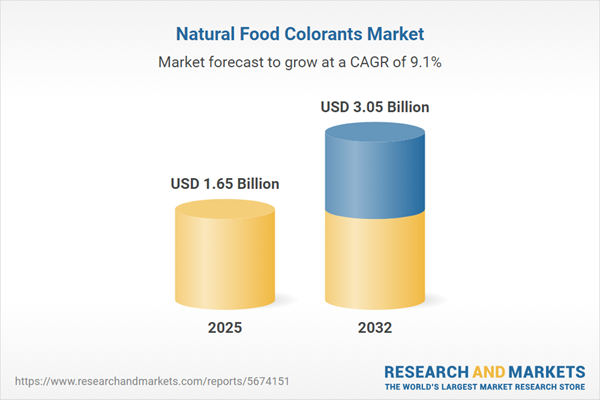Speak directly to the analyst to clarify any post sales queries you may have.
The natural food colorants market is evolving rapidly, driven by changing consumer preferences, regulatory pressures, and technological innovation. This research provides essential insights for senior executives seeking actionable intelligence on opportunities and challenges shaping the sector’s strategic direction.
Market Snapshot: Natural Food Colorants Market Size and Growth Outlook
The natural food colorants market grew from USD 1.52 billion in 2024 to USD 1.65 billion in 2025 and is positioned for continued expansion. The sector is projected to reach USD 3.05 billion by 2032, with a compound annual growth rate (CAGR) of 9.07% highlighting strong momentum.
Scope & Segmentation
- Source: Animal-based, microbial-based, and plant-based options, including flowers, fruits, leaves, roots, and vegetables.
- Pigment Types: Anthocyanins, betalains, carmine, carotenoids, chlorophylls, curcumin, and phycocyanin.
- Form: Liquid, paste, and powder colorant formats designed for flexibility across food and beverage applications.
- Solubility: Oil-soluble and water-soluble pigments support a wide range of product formulations.
- Applications: Beverages (alcoholic, dairy-based, juice, soft drinks), confectionery and bakery, dairy products (cheese, ice cream, yogurt), meat products, snacks, and culinary uses.
- Distribution Channel: Offline and online sales channels, meeting evolving customer buying preferences.
- Regional Coverage: Americas (North America, Latin America), Europe, the Middle East & Africa (with detailed country breakdowns), and Asia-Pacific (including China, India, Japan, and others).
- Key Companies: Includes Archer-Daniels-Midland Company, BASF SE, Cargill, Döhler, DSM-Firmenich, FMC Corporation, Givaudan, GNT Group, International Flavors & Fragrances, Kalsec, Kerry Group, Lycored, McCormick & Company, NATCOL, Oterra, Robertet Canada, Roha Dyechem, San-Ei Gen F.F.I., Sensient Technologies, Symrise, and V. Mane Fils.
- Technologies: Covers sustainable extraction methods, microbial fermentation, encapsulation, nanoemulsion, blockchain tracking, and IoT-based monitoring for supply chain transparency.
Key Takeaways
- Clean label trends are prompting manufacturers to switch from synthetic dyes to natural food colorants, reflecting increased consumer scrutiny over ingredient safety and sourcing.
- Health-conscious demand and environmental sustainability are central to shifting formulation strategies, with producers incorporating responsible sourcing and waste minimization.
- Regulation is tightening globally, impacting pigment approval processes and labeling requirements, requiring robust intelligence for smooth global market operations.
- Supply chain disruptions persist due to climate variability, seasonal availability, and fluctuating logistics costs, making traceability and diversified sourcing essential.
- Innovations such as sustainable botanical extraction, enzyme-assisted methods, and fermentation-based pigment production are advancing colorant availability, consistency, and stability.
- Collaboration across R&D functions is leading to customized solutions that optimize color vibrancy and stability for specific food and beverage applications.
Tariff Impact on the Natural Food Colorants Market
In 2025, increased United States tariffs on imported natural food colorants have intensified supply chain and cost management challenges. Manufacturers are diversifying supply sources, boosting domestic production, and advocating for tariff exemptions to offset margin pressures. Strategic collaboration and nearshoring are becoming critical approaches to sustain competitiveness in this evolving trade landscape.
Methodology & Data Sources
This report combines extensive primary research—over fifty executive interviews from R&D, regulatory, and supply chain functions—with thorough secondary analysis including scientific literature, regulatory filings, patents, and corporate disclosures. A multi-stage triangulation and expert review process ensures robust, reliable findings.
Why This Report Matters
- Offers practical insights for aligning procurement, R&D, and regulatory strategies with market and policy shifts.
- Supports informed investment in advanced pigment technologies, supply chain resilience, and sustainable sourcing.
- Enables benchmarking against peer companies and anticipation of market movements across key regions and segments.
Conclusion
The natural food colorants market is shaped by clean label demand, sustainability initiatives, and ongoing innovations in extraction and formulation. Decision-makers prepared to adapt sourcing, invest in technology, and collaborate across the value chain can seize growth opportunities and strengthen their competitive position.
Additional Product Information:
- Purchase of this report includes 1 year online access with quarterly updates.
- This report can be updated on request. Please contact our Customer Experience team using the Ask a Question widget on our website.
Table of Contents
3. Executive Summary
4. Market Overview
7. Cumulative Impact of Artificial Intelligence 2025
List of Figures
Samples

LOADING...
Companies Mentioned
The key companies profiled in this Natural Food Colorants market report include:- Archer-Daniels-Midland Company
- BASF SE
- Cargill, Incorporated
- Döhler GmbH
- DSM-Firmenich AG
- FMC Corporation
- Givaudan SA
- GNT Group B.V.
- International Flavors & Fragrances Inc.
- Kalsec Inc.
- Kerry Group plc
- Lycored Corp.
- McCormick & Company, Incorporated
- NATCOL aisbl
- Oterra A/S
- Robertet Canada
- Roha Dyechem Private Limited
- San-Ei Gen F.F.I., Inc.
- Sensient Technologies Corporation
- Symrise AG
- V. Mane Fils
Table Information
| Report Attribute | Details |
|---|---|
| No. of Pages | 197 |
| Published | October 2025 |
| Forecast Period | 2025 - 2032 |
| Estimated Market Value ( USD | $ 1.65 Billion |
| Forecasted Market Value ( USD | $ 3.05 Billion |
| Compound Annual Growth Rate | 9.0% |
| Regions Covered | Global |
| No. of Companies Mentioned | 22 |









